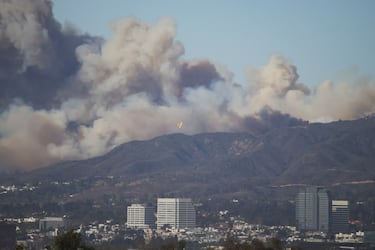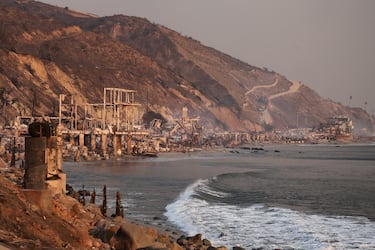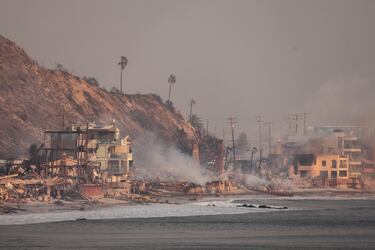Lack of Water Cited as Major Problem for Firefighters in Los Angeles: “We Pushed the System to the Extreme”
Fires in Los Angeles are straining the water supply, hampering the efforts of first responders. Why the problem is so much deeper than many think.


Los Angeles County is battling wildfires that, since they ignited on Tuesday, January 7, have consumed more than 25,000 acres and burned at least 300 structures. These fires remain completely uncontained as firefighters face harsh conditions—high winds and arid land—that allow the flames to spread wider and faster. Those on the front lines are warning that low water levels are making their job significantly more difficult. Low water pressure in hoses slows the speed at which flames can be extinguished, giving fires more time to spread.
Janisse Quiñones, CEO and Chief Engineer of the Los Angeles Department of Water and Power, held a press conference on Wednesday to update the public on water usage in the firefighting efforts and to urge residents to conserve as much water as possible. Over a 15-hour period, first responders used four times more water than is typically required to combat the Palisades Fire. “We pushed the system to the extreme,” said Quiñones, explaining that the pressure within the system began to decrease as a result, hampering efforts to contain the blaze.
“If there is a message to take away from me today, [it] is that I need our customers to really conserve water—not just in the Palisades area, but across the whole system,” pleaded Quiñones. The need for conservation stems from the challenges of fighting a massive fire while relying on an urban water system that must balance the needs of millions of residents with the urgency of containing the blaze.
Quiñones also detailed how exactly low pressure was a result of the extreme demand on the system. Three water tanks, each holding a million gallons, were fully depleted by 3:00 a.m. PT on Wednesday, reported the city’s chief engineer. As the city worked to refill them to restore pressure, firefighters continued to draw water faster than it could be pumped back into the system. To address this short-term issue, the city is deploying water trucks to fire zones, buying time to refill the tanks by reducing overall demand on the system.
The risks of scapegoating climate change
There is a growing tendency to attribute the severity and destruction of natural disasters to climate change. This discourse is often driven by a desire to highlight the tangible and deadly impacts of climate change to inspire action. In the United States, where hurricanes, tornadoes, droughts, and wildfires wreak havoc on large populations, reducing greenhouse gas emissions and preparing communities and the infrastructure they rely on to the changing environment are critical steps to mitigate future destruction, suffering, and loss of life.
But is climate change solely to blame for the low water levels, as some officials are suggesting? While climate change is undoubtedly a factor, other issues—such as manpower, equipment, emergency preparedness, and the effective deployment of resources—play a significant role in determining the effectiveness of disaster response. Quiñones' remarks highlight how the city was unpreppared for the sudden increase in demand by first responders to a crisis in an area where ecologists warn wildfires are liklely.
In Los Angeles, climate change has likely exacerbated conditions that made the Palisades and Eaton Fires possible. However, failures in governmental disaster preparedness and environmental stewardship are becoming increasingly apparent.

Los Angeles is known for its dry climate, not for abundant rainfall. Still, attributing these fires to low rainfall ignores the fact that 2024 was a wet year for the region. During the 2023-2024 season (July 2023 to June 2024), Downtown Los Angeles recorded 25.19 inches of rainfall—the second wettest season since 2005 and just behind the 2022-2023 season. Most of this rain fell in February 2024, while precipitation since July 2024 has been minimal, with only 0.16 inches recorded through December—0.15 inches below the seasonal average for that period.
While recent low rainfall and Santa Ana winds with gusts up to 100 miles per hour are challenging firefighting efforts, they are not the root cause of the devastation. Reservoir levels indicate that only three of the state’s 17 reservoirs are below their historic averages. Quiñones' remarks highlight how the city was unprepared for the sudden increase in demand by first responders to a crisis in an area where ecologists warn wildfires are likely. If the city allows residents to live in the Santa Monica Mountains, then infrastructure to combat fires must be enhanced because if not, the structures there become threats to the wider city.
The warnings have been coming for decades
For over three decades, warnings about the risks of developing in fire-prone areas like the Santa Monica Mountains have gone unheeded. In 1995, Los Angeles historian Mike Davis published an essay titled “The Case for Letting Malibu Burn,” which critiqued pro-development forces for failing to consider the environmental consequences of construction in such areas.
Davis highlighted how frequent fires in Malibu and surrounding regions were often met with misplaced blame—on environmentalists, the unhoused, or even terrorists—rather than reflection on the impact of development policies. He noted how luxury homes were repeatedly rebuilt in these fire-prone areas, sometimes more than once in a generation, perpetuating a destructive cycle.


Davis also pointed to Southern California’s early 20th-century fire suppression policies as a contributing factor. These policies prevented natural fires from burning off accumulated brush, creating an environment where fires could grow far more destructive. Mid-20th-century research supported his argument, suggesting that the severity of fires is driven more by the accumulation of fuel than by the ignition source. But, evidence of the threat posed by allowing development in an environment where fire forms part of the ecological process is useless when the state’s leaders are unwilling to limit development, often as Davis notes, by donors to their political campaigns.
Related stories
This perspective contrasts with recent claims by President-elect Donald Trump, who has blamed poor forest management and the lack of “sweeping” for California’s fires. While Davis’s argument also critiques land management practices, his focus was on limiting the influence of pro-development forces rather than simply reducing brush.
Fingers are being pointed in many directions as this disaster unfolds, but Davis’s 1990s essay predicted such events would continue without significant changes. The failures began long before Los Angeles Mayor Karen Bass took office. While it is her responsibility to ensure the city is prepared for crises, preventing disasters when possible must also be a priority. And, while the sirens have been blaring, few leaders have ever stopped to hear their warnings, let alone take action to prevent the catastrophic consequences their message contains.
Get your game on! Whether you’re into NFL touchdowns, NBA buzzer-beaters, world-class soccer goals, or MLB home runs, our app has it all. Dive into live coverage, expert insights, breaking news, exclusive videos, and more – plus, stay updated on the latest in current affairs and entertainment. Download now for all-access coverage, right at your fingertips – anytime, anywhere.
Complete your personal details to comment